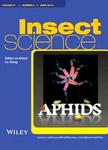Between fighting and tolerance: reproductive biology of wingless males in the ant Cardiocondyla venustula
Between fighting and tolerance: reproductive biology of wingless males in the ant Cardiocondyla venustula作者机构:LS ZoologielEvolutionsbiologie Universitat Regensburg Regensburg Germany
出 版 物:《Insect Science》 (昆虫科学(英文版))
年 卷 期:2017年第24卷第5期
页 面:818-828页
核心收录:
学科分类:0710[理学-生物学] 0830[工学-环境科学与工程(可授工学、理学、农学学位)] 07[理学] 0905[农学-畜牧学] 09[农学] 0904[农学-植物保护] 0901[农学-作物学] 090501[农学-动物遗传育种与繁殖] 0713[理学-生态学]
基 金:supported by Deutsche Forschungsgemeinschaft
主 题:Cardiocondyla ergatoid males Formicidae male competition sexual selection territoriality
摘 要:Male reproductive tactics vary widely across the species of the ant genus Cardiocondyla, from obligatory lethal combat among co-occurring males to complete mutual tolerance. The African species C. venustula Wheeler, 1908 has an intermediate phylogenetic position between taxa with fighting males and taxa with tolerant males and also shows an intermediate male behavior. Males from 2 native populations in South Africa and a population introduced to Puerto Rico attacked and killed freshly eclosing rivals but rarely engaged in deadly fights with adult competitors, Instead, several males per colony established small "territories" in their natal nests and defended them against other males. Males with a stable territory had more contact with female sexuals than nonterritorial males and more frequently engaged in mating attempts. In controlled choice experiments, female sexuals did not show any preference for particular males. We suggest that male territoriality in C. venustula is an adaptation to the seasonal production of large numbers of female sexuals by multiple mothers.



